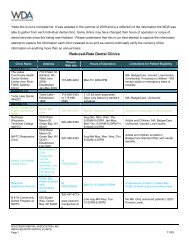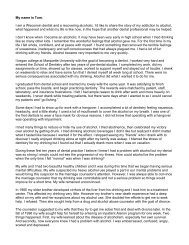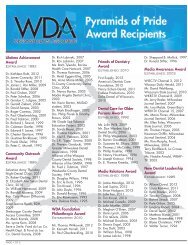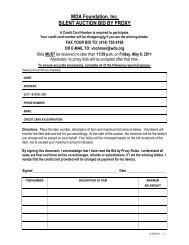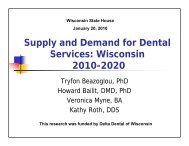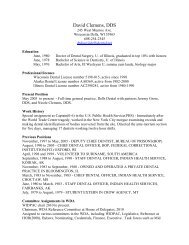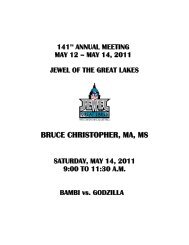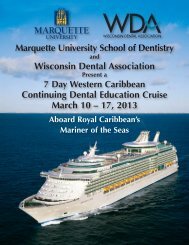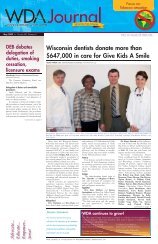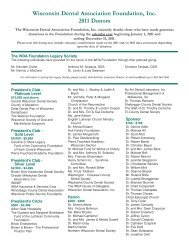Download the OSHA manual - Wisconsin Dental Association
Download the OSHA manual - Wisconsin Dental Association
Download the OSHA manual - Wisconsin Dental Association
Create successful ePaper yourself
Turn your PDF publications into a flip-book with our unique Google optimized e-Paper software.
APPENDIXUSEFUL DEFINITIONSBloodborne Pathogens: pathogenic microorganisms that are present in human blood and can causedisease in humans. These pathogens include, but are not limited to, Hepatitis B Virus (HBV), Hepatitis CVirus (HCV), and Human Immunodeficiency Virus (HIV).Contaminated: <strong>the</strong> presence or <strong>the</strong> reasonably anticipated presence of blood or o<strong>the</strong>r potentially infectiousmaterials on an item or surface (including saliva in dentistry).Decontamination: <strong>the</strong> use of physical or chemical means to remove, inactivate or destroy bloodbornepathogens on a surface or item to <strong>the</strong> point where <strong>the</strong>y are no longer capable of transmitting infectiousparticles and <strong>the</strong> surface or item is rendered safe for handling, use or disposal.Engineering Controls: mechanisms that isolate or remove <strong>the</strong> bloodborne pathogens hazard from <strong>the</strong>workplace (e.g. sharps disposal containers, self sheathing needles).Exposure Determination: means employers must identify all job classifications in which <strong>the</strong> duties includedirect contact with patient mucous membranes, and/or contaminated instruments, equipment, appliances,waste, laundry, etc. Personnel performing <strong>the</strong>se jobs could be exposed to blood or o<strong>the</strong>r potentiallyinfectious materials and are entitled to <strong>the</strong> full protection of <strong>the</strong> <strong>OSHA</strong> Bloodborne Pathogen Standard(e.g. dentist, dental assistant, hygienist, lab technician, equipment maintenance staff).Employees whose job classification does not normally include direct contact with blood or o<strong>the</strong>rpotentially infectious materials, but who may sometimes be called on to perform exposure-prone task,must be identified and a complete list of potentially exposure prone tasks <strong>the</strong>y could be asked to performmust be documented (e.g. secretary, business manager, receptionist who is asked to clean up operatory,sterilized instruments, handle contaminated equipment when dental assistant is absent).Exposure Incident: means specific eye, mouth, o<strong>the</strong>r mucous membrane, non-intact skin or parenteralcontact with blood or o<strong>the</strong>r potentially infectious materials that result from <strong>the</strong> performance of anemployee’s duties.General Duty Clause: all employers must furnish employees a place of employment free from recognizedhazards that are causing, or are likely to cause, death or serious harm.Needleless Systems: describes devices that do not use needles to collect bodily fluids or withdraw bodyfluids (after initial vascular access is established) in order to administer medication or fluids.Occupational Exposure: reasonably anticipated skin, eye, mucous membrane or parenteral contact withblood or o<strong>the</strong>r potentially infectious materials that result from performance of an employee’s duties.Sharps with Engineered Sharps Injury Protection: describes a non-needle sharp or a needle device usedfor withdrawing body fluids, accessing a vein or artery or administering medication or o<strong>the</strong>r fluids with abuilt in safety feature or mechanism that effectively reduces <strong>the</strong> risk of an exposure incident.<strong>OSHA</strong> EXPOSURE CONTROL PLAN…a member benefit from <strong>the</strong> WDAa6



